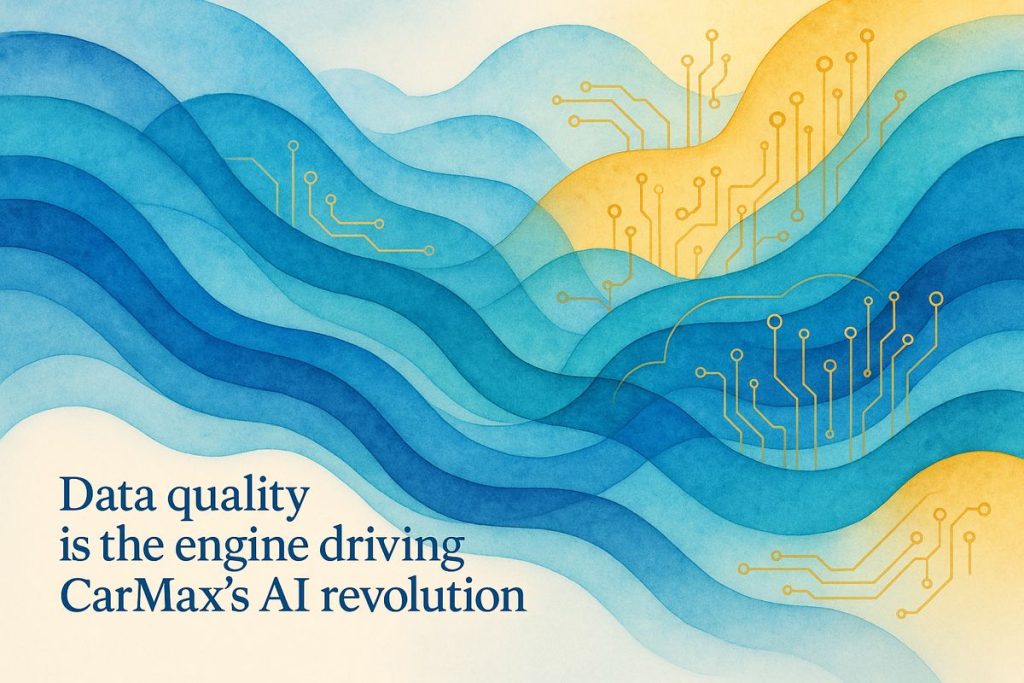CarMax changed how it uses data by moving everything to the cloud with Microsoft Azure and teaming up with Snowflake to keep all their information in one safe place. They made sure their data was super clean before letting AI step in, which helped them build powerful tools that make buying and selling cars easier and faster. Now, customers can get quick offers and easy-to-read reviews with the help of generative AI, while CarMax keeps everything secure and smooth behind the scenes. This mix of cloud smarts, shiny AI, and careful planning turned CarMax into a tech leader, not just a car lot.
How has CarMax transformed its data strategy using generative AI and cloud technology?
CarMax modernized its data strategy by migrating to Microsoft Azure for scalable cloud storage, partnering with Snowflake for centralized data warehousing, and prioritizing data quality. This foundation enabled advanced generative AI applications that streamline customer experiences, automate review summaries, and boost operational efficiency, all while ensuring security and compliance.
Cloud First, Coffee Second
If you’d told me ten years ago that CarMax—the same CarMax where my cousin once wandered the lot, hypnotized by the sheer volume of shiny used Hondas—would morph into a vanguard of data modernization, I might’ve snorted out my espresso. But here we are. The largest used car retailer in the U.S. has quietly refashioned itself as something of a Silicon Valley palimpsest, layering hyperspectral data strategy atop old-school retail DNA.
Their odyssey kicked off with a decisive, almost audacious, leap into the cloud. Picture terabytes of car histories, user reviews, and sales analytics hoisted from on-premises servers and gently set down in Microsoft Azure’s capacious embrace (Microsoft Cloud Blog). If you listen closely, you can almost hear the hum of those virtual machines—like a beehive at dawn.
But migrating to Azure was just the overture. Enter Snowflake, that quietly transformative data warehousing whiz. CarMax’s partnership with Snowflake wasn’t a mere vendor swap; it was a deliberate act of infrastructural origami. By centralizing operations, shoring up their pipelines, and enlisting Snowflake’s expertise, CarMax sidestepped the classic data silos that can turn analytics into a Kafkaesque labyrinth (CIO Dive). I had to stop and ask myself: When did car dealerships start sounding more like MIT labs than, well, car dealerships?
Sequencing the DNA of Innovation
You can almost imagine CarMax’s execs pacing their glass-walled offices, debating which comes first: AI wizardry or data hygiene. Turns out, they went with the latter. “I don’t end a day without bringing up the importance of data and data quality for AI,” confessed Abhi Bhatt, their VP of Technology, Data and AI. This wasn’t just idle talk.
Instead of bolting bleeding-edge tech onto a rickety scaffolding, CarMax chose the plodding (but ultimately gratifying) path of sequencing. First, a relentless focus on data quality—think of it as scrubbing every speck off a microscope slide before peering through to spot the next big thing. Only then did the real AI experiments begin. It’s almost enough to make a data purist misty-eyed.
I’ll admit, I once fell for the siren song of “AI first, clean up later” on a past project. Spoiler: we spent six months untangling spaghetti code and apologizing to the analytics team. Lesson learned—sometimes you have to slow down to speed up. Ugh.
Generative AI at the Wheel
With the data foundation finally humming, CarMax unleashed a swarm of generative AI applications—and the results were anything but theoretical. Customers uploading a photo of their license plate now receive instant, seven-day offers for their vehicle, a feature that jacked up car purchases significantly after its early 2022 debut.
But that’s only the tip of the iceberg. Using Azure OpenAI Service, CarMax digests and distills thousands of customer reviews into pithy, research-friendly summaries, making the previously daunting task of sifting through page after page of feedback as easy as thumbing through a well-indexed encyclopedia. Meanwhile, machine learning models now handpick the most compelling car images—think “Tinder for Camrys”—adding a tactile element to the virtual shopping experience.
Internally, engineering and product teams have their own digital sous-chef: Microsoft 365 Copilot. Productivity ticked upward, code reviews took less time, and, rumor has it, even the number of caffeine-fueled late nights dipped. Can AI refactor a poorly written pun? Not yet.
Security, Stewardship, and a Smidge of Skepticism
Of course, innovation without safeguards is a bit like test-driving a Porsche on black ice—thrilling, but fraught. Shamim Mohammad, the Chief Information and Technology Officer, keeps integrity, trust, and transparency at the fore. When CarMax migrated from OpenAI’s public API to the more stringent Azure OpenAI Service, it wasn’t just about ticking compliance boxes (Prismware). It was an act of stewardship—guarding customer data like a dragon guards its hoard.
Kevin Hopwood, Cloud Solutions Architect, even described the transition as “surprisingly smooth.” I laughed when I read that—since when does a major IT migration not spawn at least one existential crisis? Maybe the secret is meticulous planning. Or maybe it’s just getting lucky. Either way, relief mingled with my skepticism, like cream swirling into strong coffee.
CarMax also eyes hybrid cloud like a chess player strategizing three moves ahead. By leveraging Nutanix Clusters on Azure, they can prototype and launch new features with alacrity, hedging against the fickle winds of market demand.
